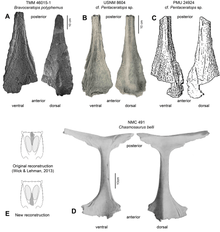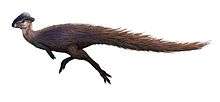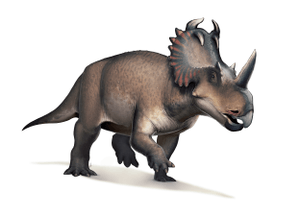Bravoceratops
"Bravoceratops" is a dubious genus of large chasmosaurine ceratopsid dinosaur that lived approximately 70 million years ago, and is known from the Late Cretaceous Javelina Formation in what is now Texas, United States.
| Bravoceratops | |
|---|---|
| Scientific classification | |
| Kingdom: | Animalia |
| Phylum: | Chordata |
| Clade: | Dinosauria |
| Order: | †Ornithischia |
| Family: | †Ceratopsidae |
| Subfamily: | †Chasmosaurinae |
| Genus: | †Bravoceratops Wick & Lehman, 2013 |
| Type species | |
| †Bravoceratops polyphemus Wick & Lehman, 2013 | |
Discovery and naming

The genus name means "wild horn-face", and is derived from the Mexican name for the Rio Grande, "Rio Bravo del Norte" (wild river of the north), and the Greek words "keras" (κέρας) meaning "horn" and "ops" (ὤψ) referring to the "face".[1] The specific name polyphemus, refers to the giant cyclops Polyphemus confronted by Odysseus in the Greek epic poem, The Odyssey. The genus was described and named by Steven L. Wick and Thomas M. Lehman in 2013 and the type species is Bravoceratops polyphemus.[2]

"Bravoceratops" is only known from the holotype specimen TMM 46015-1, which consists of a fragmentary skull. It was recovered at the "Hippiewalk" locality from the lowermost part of the Javelina Formation, in Big Bend National Park, Texas. The specimen was collected in sandy conglomerate sediment that was deposited during the early Maastrichtian stage of the Cretaceous period, approximately 70 million years old. It is housed in the collection of the Texas Memorial Museum, Austin, Texas. The various parts of the holotype skull were completely disarticulated and scattered across an area of approximately ten square meters prior to fossilization. Many of the more robust remains, such as the horns, exhibit weathering and erosion. This circumstance suggests that the skull remained exposed for a time before burial. Although the recovered portions of the skull showed signs of fluvial transport, they were otherwise found in excellent condition.[2]
Two autapomorphies (unique derived traits) were originally proposed. Firstly, the median parietal bar (the bone bar between the frill openings) at mid-length splays out to the rear like a fan and its rear edge is not notched or embayed. Secondly, the upper surface of the bar is, at the midline, hollowed out by a symmetrical depression. It is this hollow in the form of an inverted tear that occasioned the specific name as it resembled the single eye of a cyclops, thus the allusion with Polyphemus. The authors assumed it formed the base of a horn-like epiparietal. This would imply that a second midline epiparietal (a small horn-like structure), unpreserved in the fossil, had been present. In 2020, paleontologists Denver W. Fowler and Elizabeth A. Freedman Fowler suggested that the parietal median bar of the specimen had been reconstructed upside down, and that the genus therefore did not have any distinguishing features, making it a nomen dubium.[3]
Classification
"Bravoceratops" is assigned to the Chasmosaurinae. It is an "intermediate" form of chasmosaurine; it, along with genera like Pentaceratops and Anchiceratops, was distinctly more derived than forms like Chasmosaurus but less so than taxa like Triceratops. Its position in a phylogenetic analysis performed by Wick and Lehman (2013), who first named the taxon. It was found that "Bravoceratops" may be the sister taxon of Coahuilaceratops; however, this relationship was only weakly supported - it is based on shared three characters (anatomical states) which are widespread in more basal chasmosaurines. Parietals (fused bones which form most of the frill) are not preserved in known specimens Coahuilaceratops, which impedes comparison due to the importance of the parietal in certopsid taxonomy. Where these two genera fall out within Chasmosaurinae was found to be inconsistent across the two analyses performed. The first analysis, with unmodified characters from a previous study, found the pair to be relatively basal . The second, with two added characters, instead found "Bravoceratops" to be a relatively derived taxon. Both positions were considered to be somewhat unintuitive; several of its derived characters would be odd for a taxon in the basal position, but the genus also possessed few primitive characters would require evolutionary reversals if the more derived position was correct. Regardless, the more derived placement was considered to be somewhat more likely. The first tree is reproduced on the left, and the second on the right:[2]
|
|
Future studies found trees showing the derived position, with "Bravoceratops" found related to Arrhinoceratops and Triceratopsini. However, the fragmentary nature of Bravoceratops caused it to generally be removed from phylogenetic analyses, as it was a wildcard taxon (meaning it was unstable and caused poorer results).[4][5][6] Fowler and Freedman Fowler (2020) recovered it in the more basal position, close to Pentaceratops, and once again sister to Coahuilaceratops. However, they also decided to remove it from their analysis due to their conclusion the taxon was invalid.[3]
See also
References
- Liddell, Henry George and Robert Scott (1980). A Greek-English Lexicon (Abridged Edition). United Kingdom: Oxford University Press. ISBN 0-19-910207-4.
- Wick, S. L.; Lehman, T. M. (2013). "A new ceratopsian dinosaur from the Javelina Formation (Maastrichtian) of West Texas and implications for chasmosaurine phylogeny". Naturwissenschaften. 100 (7): 667–82. Bibcode:2013NW....100..667W. doi:10.1007/s00114-013-1063-0. PMID 23728202.
- Fowler, D. W.; Freedman Fowler, E. A. (2020). "Transitional evolutionary forms in chasmosaurine ceratopsid dinosaurs: evidence from the Campanian of New Mexico". PeerJ. 8: e9251. doi:10.7717/peerj.9251.
- Campbell, James A. (2015). "A reassessment of the horned dinosaur Judiceratops tigris (Ornithischia: Ceratopsidae) from the Upper Cretaceous (Campanian) of Montana, USA". Canadian Journal of Earth Sciences. 52 (2): 85–95. doi:10.1139/cjes-2014-0172.
- Campbell, James A.; Ryan, Michael J.; Holmes, Robert B.; Schröder-Adams, Claudia J. (2016). "A Re-Evaluation of the Chasmosaurine Ceratopsid Genus Chasmosaurus (Dinosauria: Ornithischia) from the Upper Cretaceous (Campanian) Dinosaur Park Formation of Western Canada". PLoS One. 11 (1): e0145805. doi:10.1371/journal.pone.0145805.
- Mallon, Jordan C.; Holmes, Robert; Anderson, Jason S.; Farke, Andrew A.; Evans, David C. (2014). "New information on the rare horned dinosaur Arrhinoceratops brachyops (Ornithischia: Ceratopsidae) from the Upper Cretaceous of Alberta, Canada". Canadian Journal of Earth Sciences. 51 (6): 618–634. doi:10.1139/cjes-2014-0028.


